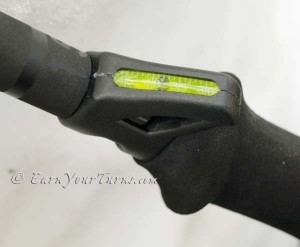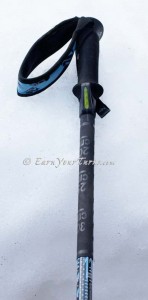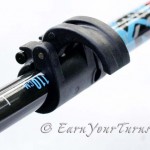The new LockJaw® Carbon/Carbon and Carbon/Alu ski poles from K2 take the concept of functionality for a ski pole to a new level. The core features remain, like the Lock-Jaw® clamp that holds reliably and is easy to adjust. But what originally distinguished K2’s backcountry ski poles from the competition, depth readings and slope indicators, are significantly improved with next years models.

Bubble gauge inclinometer tucks under the handle, indicates slopes skiers are intersted in.
click to enlarge
In the models with the bubble gauge inclinometer, depth readings adorn both poles, not just one. Turn the pole upside down and probe down into the snow. Numbers are shown on the pole shaft every five centimeters up to 40 cm, to indicate depth relative to the top of the handle. On the Carbon/Carbon model the depth numbers are kind of hard to read. They blend in, but once you recognize ‘em they’re obvious enough. Part of the reason you don’t notice them immediately is because the first 40 cm of shaft beneath the handle is a grippy sheath that makes it super easy to choke up on the pole while traversing. Then you notice that the numbers are part of this rubbery sheath, hence the blended visibility of the depth numbers. The rubbery sheath grips well in a variety of temperatures, and snow does not stick to it.
Compared to the inaugural version of K2’s ski poles, the LockJaw™ on this latest pair of poles is noticeably improved. When they are locked now, the pole holds – no exceptions.
The baskets are a clear notch better too, providing lots of solid surface area for better flotation in the fluffy stuff. More importantly, the retention of the baskets is higher too, meaning you’re less likely to lose your basket when it plunges beneath a crust and you have to pull it back out with a lot of force.

Ergonomic handle, wide straps with no plastic to break, and depth numbers on a grippy sheath. Nice. Very nice.
click to enlarge
2-year Update
It’s been two years since reviewing these poles. They remain my go-to pair of poles, or are the single pole I keep as the baseline of comparison when evaluating other poles. The closest equivalent pole in terms of quality, durability, comfort and reliability of the locking mechanism are Black Diamond’s FlickLock® poles, especially the updated FlickLock® Pro version. The main thing I prefer with the K2 Lockjaw ® poles are the straps without any plastic clips for adjusting length.

The rubber sheath seemed like such a good idea. In reality, it slips, then bunches up. I finally cut it off.
Conclusion
If you’re in the market for a new set of adjustable poles, K2s LockJaw series poles are worth considering. You might find a better price, but not a better feature set.
Lock Jaw Carbon-Carbon Probe
Weight/pole: 8.7 oz. (248 g)
MSRP: $179.95
Lock Jaw Carbon-Alu Probe
Weight/pole: 10.3 oz. (295 g)
MSRP: $139.95
Lock Jaw Alu 3-piece Adjustable
Weight/pole: 10.4 oz. (296 g)
MSRP: $109.95
Backside Carbon
Weight:
MSRP: $99.95
Lockjaw Alu
Weight/pole: 10 oz. (286 g)
MSRP: $79.95
© 2011



1 comment
4 pings
Great tool to have at the finger tips. No guessing. The only thing missing is a self-arrest grip which would make it even more practical, but K2 does not make a self arrest grip.
[…] than twist-lock adjustable poles, even BD’s FlickLock® concept could be improved upon (see K2 & Leki), so they did. FlickLock® Pro opened […]
[…] is a pair of ski poles and a cursory understanding of basic trigonometry. Incidentally, K2′s LockJaw® ski poles come with marks on the shafts to help with this, and their Carbon/Carbon model also has a bubble […]
[…] than a cammed locking mechanism like BD’s Flick-Lock or the many variations like K2′s Lock-Jaw or Leki’s Speed Lock? No, it can’t be claimed as superior, but perhaps equal in terms […]
[…] is a pair of ski poles and a cursory understanding of basic trigonometry. Incidentally, K2′s LockJaw® ski poles come with marks on the shafts to help with this, and their Carbon/Carbon model also has a bubble […]